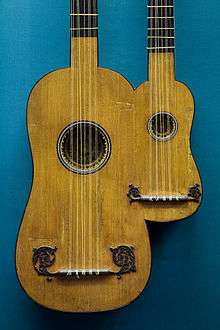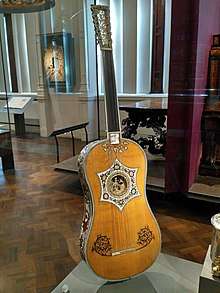Baroque guitar
The Baroque guitar (c. 1600–1750) is a string instrument with five courses of gut strings and moveable gut frets. The first (highest pitched) course sometimes used only a single string.[1]
 Baroque guitar built by Matteo Salas, c. 1630–50 | |
| Hornbostel–Sachs classification | 321.322 (plucked) |
|---|---|
| Developed | 17th century |
| Attack | Fast |
| Related instruments | |
| Musicians | |
History
The Baroque guitar replaced the Renaissance lute as the most common instrument found when one was at home.[2][3] The earliest attestation of a five-stringed guitar comes from the mid-sixteenth-century Spanish book Declaracion de Instrumentos Musicales by Juan Bermudo, published in 1555.[4] The first treatise published for the Baroque guitar was Guitarra Española de cinco ordenes (The Five-course Spanish Guitar), c. 1590, by Juan Carlos Amat.[5][6]
The baroque guitar in contemporary ensembles took on the role of a basso continuo instrument and players would be expected to improvise a chordal accompaniment. Several scholars have assumed that the guitar was used together with another basso continuo instrument playing the bass line.[7] However, there are good reasons to suppose that the guitar was used as an independent instrument for accompaniment in many situations.[8] Intimately tied to the development of the Baroque guitar is the alfabeto system of notation.
Tuning
Three different ways of tuning the guitar are well documented in seventeenth-century sources as set out in the following table. This includes the names of composers who are associated with each method. Very few sources seem to clearly indicate that one method of stringing rather than another should be used and it is often argued that it may have been up to the player to decide what was appropriate. The issue is highly contentious and different theories have been put forward.[9][10][11]
A very brief list of composers and tunings:


| Composers | Tuning | Scale |
|---|---|---|
| Ferdinando Valdambrini (Italy, 1646/7) Gaspar Sanz (Spain, 1674) |  | E - B - G - D - A |
| Antoine Carre (France, 1671) Robert de Visée (France, 1682)[12] Nicolas Derosier (Netherlands, 1690) |  | E - B - G - D (in octave) - A |
| Girolamo Montesardo (Italy, 1606) Benedetto Sanseverino (Italy, 1620) Giovanni Paolo Foscarini (Italy, 1640) Francisco Guerau (Spain, 1694) |  | E - B - G - D (in octave) - A (in octave) |
Composers
- Giovanni Paolo Foscarini (c.1600 - 1650)
- Angelo Michele Bartolotti (c.1615-1680)
- Giovanni Battista Granata (1620 - 1687)
- Gaspar Sanz (c.1640–1710)
- Robert de Visée (c. 1658 – 1725)
- Francisco Guerau (1649 - 1722), Poema harmonico
- Francesco Corbetta (1615–1681)
- Henri Grenerin (fl. mid-17th century)
- Ludovico Roncalli (1654 - 1713)
- Santiago de Murcia (c. 1673 - 1739)
Sample of makers
Matteo Salas (1600s).
Antonio Stradivari (1644–1737). Of his five surviving guitars, the 1679 "Sabionari"[13] is the only one in playable condition. It is the solo instrument on more than a dozen videos at YouTube.com. Two other Stradivari guitars are in museums. An instrument of 1688[14] is in the Ashmolean Museum in Oxford, England, and an instrument of 1700[15] is in the National Music Museum in Vermillion, South Dakota.
Nicholas Alexandre Voboam II (c. 1634/46–1692/1704). French luthier with three guitars bearing his signature (from a total of 26 attributed to the Voboam Family).[16][17] The guitars of Alexandre were held in high esteem during his lifetime and a century later were still considered desirable instruments.[18]
Contemporary makers of baroque guitars can be identified by Internet searches.
Performers
.jpg)
- David Ryckaert III (Antwerp 1612–1661)
- Lex Eisenhardt
- Eduardo Egüez
- Paul O'Dette
- Hopkinson Smith
- Stephen Stubbs
- Xavier Díaz-Latorre
- Rolf Lislevand
- Nigel North
- Jakob Lindberg
- Stephen Stubbs
- Barry Mason
- Ugo Nastrucci
- Andrea Damiani
- Massimo Lonardi
- James Tyler
- Patrick O'Brien
Gallery
.jpg) Baroque guitar by Matteo Seelos (before 1653)
Baroque guitar by Matteo Seelos (before 1653)_by_Jean-Baptiste_Voboam%2C_and_Joachim_Tielke%2C_National_Museum_of_American_History.jpg) Five-course guitars by Jean-Baptiste Voboam (ca.1695) and Joachim Tielke (ca.1695–99)
Five-course guitars by Jean-Baptiste Voboam (ca.1695) and Joachim Tielke (ca.1695–99)
 Modern copy of Baroque guitar
Modern copy of Baroque guitar Baroque guitar at the Casa Museo Del Timple, Lanzarote, Spain.
Baroque guitar at the Casa Museo Del Timple, Lanzarote, Spain. A baroque guitar by Joachim Tielke in the V&A Museum, London, UK.
A baroque guitar by Joachim Tielke in the V&A Museum, London, UK.
Bibliography
- Lex Eisenhardt, Italian Guitar Music of the Seventeenth Century, University of Rochester Press, 2015.
- Lex Eisenhardt, "Bourdons as Usual". In The Lute: The Journal of the Lute Society, vol. XLVII (2007)
- Lex Eisenhardt, "Baroque guitar accompaniment: where is the bass". In Early Music, vol. 42, No 1 (2014)
- Lex Eisenhardt, "A String of Confusion"
- James Tyler, "The Early Guitar", Oxford University Press, 1980.
- James Tyler/Paul Sparks, The Guitar and its Music", Oxford University Press, 2002.
- James Tyler, " A guide to playing the Baroque Guitar" Indiana University Press, 2011.
- Monica Hall: Baroque Guitar Stringing : a survey of the evidence (Guildford: The Lute Society, 2010) ISBN 0-905655-40-0
- Monica Hall: "Recovering a lost book of guitar music by Corbetta". In Consort: The Journal of the Dolmetsch Foundation, Vol. 61 (2005). ISSN 0268-9111
- Monica Hall: "The "Guitarra espanola" of Joan Carles Amat". In Early Music, Vol. 6, no. 3, July 1978.
- Monica Hall: "Dissonance in the guitar music of Francesco Corbetta". In Lute: The Journal of the Lute Society, Vol. XLVII (2007)
- Monica Hall: "Angiol Bartolotti's Lettere tagliate". In Lute: The Journal of the Lute Society, Vol. XLVII (2007)
- Monica Hall: "Tuning instructions for the baroque guitar in Bibliotheque Nationale Res. Vmc Ms. 59, f. 108v". In Lute: The Journal of the Lute Society, Vol. XLVII (2007)
- Antoni Pizà: Francesc Guerau i el seu temps (Palma de Mallorca: Govern de les Illes Balears, Conselleria d'Educació i Cultura, Direcció General de Cultura, Institut d'Estudis Baleàrics, 2000). ISBN 84-89868-50-6
- Hélène Charnassé, Rafael Andia, Gérard Rebours, The Guitar Books of Robert de Visée, Paris: Editions Musicales Transatlantiques,2000, 235 pages.
- Thomas Schmitt: "Sobre la ornamentación en el repertorio para guitarra barroca en España (1600-1750)". In: Revista de Musicología, XV, nº 1, 1992
- Giovanni Accornero, Eraldo Guerci (edited and translated by Davide Rebuffa) - The Guitar: "Four Centuries of Masterpieces", (Italian/English), Edizioni Il Salabue, 2008. ISBN 978-88-87618-13-6
- Carlo Alberto Carutti, "Passioni di un collezionista", Catalogue by Giovanni Accornero (edited and translated by Davide Rebuffa), (Italian/English), Edizioni Il Salabue, 2011. ISBN 978-88-87618-15-0 (also available on CD rom)
References
- Harvey Turnbull, The Guitar (From The Renaissance to the Present Day) (3rd impression 1978), London: Batsford (ISBN 0 7134 3251 9), p. 15: "Early lutes, vihuelas and guitars share one important feature that would have been of practical concern to the player; the frets, unlike the fixed metal frets on the modern guitar, were made of gut and tied round the neck" (Chapter 1 - The Development of the Instrument).
- Manfred F Bukofzer, Music In The Baroque Era (From Monteverdi to Bach), London: J. M. Dent & Sons (1st UK edition 1948), p. 47: "The Spanish fashion in Italy brought a speedy victory of the nosiy guitar over the dignified lute".
- Donald Jay Grout, A History Of Western Music, London: J. M. Dent & Sons, 1962, Chapter 7: New Currents In The Sixteenth Century, p. 202: "By far the most popular household solo instrument of the Renaissance was the lute."
- Tom and Mary Anne Evans, Guitars: From the Renaissance to Rock, London: Paddington Press, 1977, p. 24: "The first incontrovertible evidence of five-course instruments can be found in Miguel Fuenllana's Orphenica Lyre of 1554, which contains music for a vihuela de cinco ordenes. In the following year Juan Bermudo wrote in his Declaracion de Instrumentos Musicales: 'We have seen a guitar in Spain with five courses of strings.' Bermudo later mentions in the same book that 'Guitars usually have four strings,' which implies that the five-course guitar was of comparatively recent origin, and still something of an oddity."
- Harvey Turnbull, The Guitar (1978), p. 41 (Chapter 3 - The Baroque, Era Of The Five Course Guitar): "The new era is heralded by Juan Carlos Amat's little treatise Guitarra Espanola de cinco ordenes...."
- Evans, Guitars (1977), p. 24: "We know from literary sources that the five course guitar was immensely popular in Spain in the early seventeenth century and was also widely played in France and Italy....Yet almost all the surviving guitars were built in Italy....This apparent disparity between the documentary and instrumental evidence can be explained by the fact that, in general, only the more expensively made guitars have been kept as collectors' pieces. During the early seventeenth century the guitar was an instrument of the people of Spain, but was widely played by the Italian aristocracy."
- Manfred F. Bukofzer, Music In The Baroque Era (From Monteverdi to Bach), London: J. M. Dent & Sons (1st UK edition 1948), p. 26: "The basso continuo ... required at least two players, one to sustain the bass line (string bass, or wind instrument) and the other for the chordal accompaniment (keybooard instruments, lute, theorboe, and the popular guitar)."
- Lex Eisenhardt, ‘Baroque guitar accompaniment: where is the bass’ Early Music 42, No 1 (2014) p. 73-84.
- Monica Hall, Baroque Guitar Stringing : a survey of the evidence (Guildford: The Lute Society, 2010) ISBN 0-905655-40-0.
- Lex Eisenhardt, Italian Guitar Music of the Seventeenth Century, University of Rochester Press (2015).
- James Tyler and Paul Sparks, The Guitar and Its Music (Oxford University Press, 2002).
- Robert de Visée, Livre de guitare dédié au roy: "...il ne faut pas oublier une octave à la quatrième corde, elle y est très nécessaire".
- "The Sabionari Guitar". sabionari.com.
- "Guitar 1688". ashmoleanprints.com.
- "Guitar". emuseum.nmmusd.org.
- The Guitar (From The Renaissance To The Present Day) by Harvey Turnbull (Third Impression 1978) - Publisher: Batsford (ISBN 0 7134 3251 9) - p20 (Chapter 1 - The Development Of The Instrument)
- "Recent Research About The Voboam Family And Their Guitars by Florence Gétreau (Heritage Curator for 20 years at the Conservatoire de Paris and Director of Research at Institut de recherche sur le patrimoine musical en France)" (PDF).
- The Guitar (From The Renaissance To The Present Day) by Harvey Turnbull (Third Impression 1978) - Publisher: Batsford (ISBN 0 7134 3251 9) - p20 "Alexandre's reputation lasted long after the seventeenth century. An advertisement in the Journal de Musique for September 1770 offered 'an excellent guitar made in Paris by the celebrated Voboam in 1675'.... "(Chapter 1 - The Development Of The Instrument)
External links
| Wikimedia Commons has media related to Baroque guitars. |
- Technique "Baroque guitar for the modern performer - a practical compromise", by Don Rowe and Richard d’A Jensen
%2C_Martin_Style_3-17_(1859)_-_C.F._Martin_Guitar_Factory_2012-08-06_-_011.jpg)